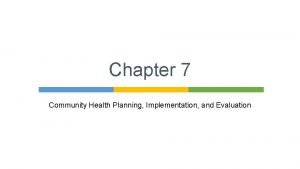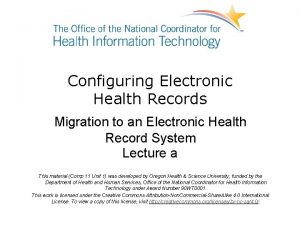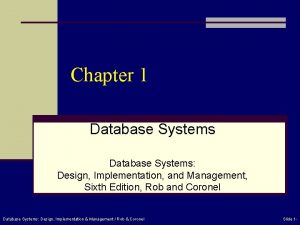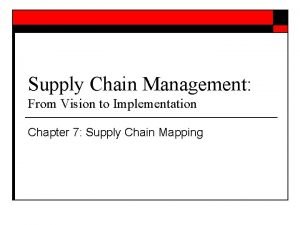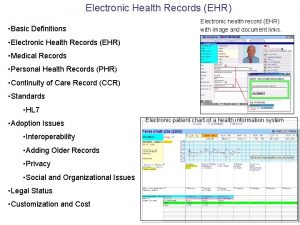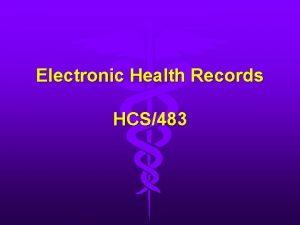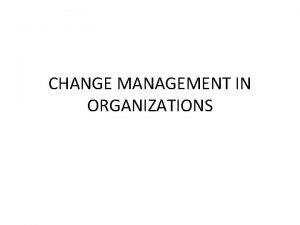CHANGE MANAGEMENT IN THE IMPLEMENTATION OF ELECTRONIC HEALTH

















- Slides: 17

. CHANGE MANAGEMENT IN THE IMPLEMENTATION OF ELECTRONIC HEALTH RECORDS SYSTEMS IN PUBLIC AND PRIVATE HOSPITALS IN THE ETHEKWINI AREA BY MANDISA MSOMI DEPARTMENT OF INFORMATION STUDIES UNIVERSITY OF ZULULAND, SOUTH AFRICA

PRESENTATION OUTLINE � INTRODUCTION AND BACKGROUND � PROBLEM AND PURPOSE � OBJECTIVES � RESEARCH METHODOLOGY � IMPORTANCE OF CHANGE MANAGEMENT IN EHR SYSTEMS � CHALLENGES IN THE IMPLEMENTATION OF EHR SYSTEMS � MONITORING AND EVALUATION OF EHR SYSTEMS � CONCLUSION


INTRODUCTION AND BACKGROUND • • • For many years hospitals have been managing health records manually. • Public and private hospitals or health care providers are adopting the use of technology for the benefit of patient care, higher quality, fewer errors and greater efficiency (Luxford & Safran, 2011). • The adoption of EHR systems often has less to do with technology but more to do with underlying changes in the business, clinical processes, and workflow for daily tasks (Martin and Voynov, 2014). • It is common for organisations to overlook the importance of change management processes in the overall plan of EHR implementation and only involve users in the operation phase (Schmucker, 2009) • Effective implementation and operation of EHR systems requires a well structure change management approach. • Change management is regarded as a discipline that guides how people prepare, equip and support individuals to successfully adopt the implementation, in order to drive the organisation Hospitals are changing to electronic health records systems for day to day functioning. Electronic health records are digital version of patient’s collected information available instantly and securely to authorised users (Katuu, 2015).

HEALTH INFORMATION TECHNOLOGY IN SOUTH AFRICA • National Health Act (NO. 61 of 2003) indicates that the National Department of Health (NDOH) has the mandate to facilitate and coordinate the establishment, implementation and sustainability of health information systems across national, provincial and local level including the private health sector. • The adoption of electronic health records systems in South Africa is driven by the national e. Health strategy that normalizes the use of information and communication technology for health related purposes (e. Health strategy of South Africa, 2012 -2017). • The e-Health strategy of South Africa is set to ensure effective adoption and successful implementation of health information systems (Emarus & Van der Walt, 2015: 187). • The aim of the e-Health strategy of South Africa is to lay basis for future incorporation and coordination of e-Health initiatives in public and private health sector (e. Health strategy of South Africa, 2012: 8). • The EHR system is envisioned to support the National Health Insurance anticipated to improve the availability and accessibility of health care services for South African citizens (Munyaradzi & Katurura, 2018: 1) • The e-Health strategy of South Africa has insufficient directive on change management in the implementation of health information technology for healthcare organisations.

BACKGROUND OF THE STUDY • The developments and alignment of health information systems in the Kwa-Zulu Natal province is still work in progress. • The Kwazulu-Natal department of health embarked and operated EHR systems years ago; yet not all hospitals use the EHR systems. • There is no notable evidence of literature, that mentions the impact of change management in the pre or post implementation of health information technology in the province, particularly in the e. Thekwini area.

PROBLEM STATEMENT • South Africa has been attempting the implementation of electronic health records systems in both public and private hospitals. • The concerns and issues of managing change in their implementation have not been fully addressed. • Several previous studies by (Luthuli, 2017; Marutha, 2016; Thomas, 2016; Katuu, 2015; Marutha, 2012; Weeks, 2012) have pointed out the necessity of implementing EHR systems to improve health service delivery in South Africa; the question regarding management of change has not been fully examined in depth. • It is in this regard, the researcher comparatively evaluate change management orientation in operation of EHR systems in public and private hospitals in the e. Thekwini area

AIM OF THE STUDY • To assess change management in the implementation of electronic health records systems in public and private hospitals in the Ethekwini Area.

OBJECTIVES • To determine factors facilitating the adoption of EHR systems in public and private hospitals. • To determine changes experienced by hospital and health workers due to EHR system implementation. • To find out how hospitals monitor and evaluate the impact of EHR system implementation. • To find out tools used by hospital leadership to reinforce change and sustain results. • To recommend effective change management strategy for electronic health records systems in public and private hospitals in the Ethekwini Area.

THEORETICAL FRAMEWORK • The study use Leading Change model in integration with Technology Acceptance model to assess change management effectiveness in the EHR system implementation. • The models are chosen upon the foundation of earlier studies by Martin and Voynov, (2014) that utilized the leading change model with TAM in the implementation of EHR in physician practices. • TAM model complement Kotter Leading Change model as it focuses on the perception of the group (healthcare providers) experiencing change in relation to specific variables such as perceived usefulness and ease of use due to EHR systems implementation (Martin and Voynov, 2014).

RESEARCH METHODOLOGY Research Paradigm Research design Research Method Targeted Population Sampling Research Instrument / Data collection Tool Data analysis Positivist Quantitative Survey Public Hospital =125 Private Hospital=98 Probability sampling-Stratified random technique -Questionnaires -Interviews -Observation -Triangulated using both qualitative and quantitative -Thematically (themes and sub-headings) -Descriptive statistics-frequencies, bar graphs and pie charts, table and bar graphs.

IMPORTANCE OF CHANGE MANAGEMENT IN THE IMPLEMENTATION OF EHR SYSTEMS. • Electronic health records systems are complex to implement owing to human capital mind-set, identification of electronic records management systems and organisational culture (Marutha, 2016) • Fast technological changes and improvements have inclined the way corporate world function weather in public or private health sector (Shonhe, 2017: 19). • Change management is an attempt to address the issues that can cause change to be poorly managed in an organisation (Cameron and Green, 2015). • Hospitals need to understand changes resulting from the use of EHR systems in the pre and post implementation process. • Change management is a large part of the implementation life cycle, as it aid to the meaningful use of the EHR system. • Change management provides hospitals with a sense of direction, it positions users and management role in the implementation process. • Change management remains a central ingredient to the successful implementation of electronic health records systems in South Africa (Katuu, 2015 & Marutha, 2016) • Change management provide users with proper set of skills to easily use the EHR systems, in order to satisfy their job requirements, needs of patients and fulfil the mission of health organisation (Mc. Carthy and Eastman, 2010).

CHALLENGES FACING HOSPITALS IN THE IMPLEMENTATION OF EHR SYSTEMS Public hospital indicated that: • The training in the use of EHR systems demands time from hospital staff, time that is taken away from patient care. • The interface around the system may not meet users requirements; for an example each doctor may have a different ways of doing things but the system may not be accommodative in terms of what the doctor is trying to achieve. • Companies developing the software for EHR systems leaves the country and it becomes a problem for the hospital to manage the system. • When number of patients captured and treated using the system increases and reach a certain number, data storage becomes insufficient. • EHR system need to be merged to increase storage and to accommodate changes in the way new or existing patients are treated.

CHALLENGES FACING HOSPITALS IN THE IMPLEMENTATION OF EHR SYSTEMS Private hospital indicated that: • The hospital is not fully electronically as managing turnover that comes with the implementation of EHR system seems to be extremely costly. • Some aspect of the health services are still very manual in the hospital for example doctor’s notes, prescription chat and nursing notes. One of the management personnel said: “The hospital has moved from one system to another, when new system was introduced the old system was not completely cut off, due to patient valuable information therefore this cause frustration and resistance to system users and billing conflict between the hospital and patients” • Instead of one consolidated EHR system, the hospital utilize multiple systems for different health activities including management of health records. • The hospital digitize medical information and create new record for each

MONITORING AND EVALUATION OF ELECTRONIC HEALTH RECORDS SYSTEMS IN HOSPITALS • No official valid measurements or tools to conduct monitoring and evaluation of EHR systems in the hospitals. • Calls logged by users are utilized to measure trending challenges encountered in the utilization of EHR systems. • • • Identifying discrepancies ih • Case studies and user studies (questionnaires) are used to measure effectiveness in the operation of EHR systems • The system generates errors report and each manager inform their staff to rectify errors and fill missing information. n the information captured and billing report. Time spent by health workers on the system versus with patients. Data captured on the system is used to monitor staff productivity. Data coding is utilized to verify if EHR users are following the correct procedures and also determines if users needs more training.

CONCLUSION • There is no standardised change management method guiding public and private hospitals in the implementation process of EHR systems. • There is a need to create a change management frameworking guiding the pre and post implementation of EHR systems. • The hospitals should involve health employees more from the initiation stage in the implementation process not only in the operation process. • There should be standardised policies and procedure guiding the monitoring and evaluation of the EHR systems. • The hospitals should have monitoring and evaluation office responsible for assessing efficient use of EHR systems and alignments in skill development.

. Who leads change management? What are the components of change management? Where and in what ways the discussions of change management suppose to take place?
 Change management in ehr implementation
Change management in ehr implementation Is the electronic exchange of money or scrip
Is the electronic exchange of money or scrip Electronic news gathering and electronic field production
Electronic news gathering and electronic field production Community health planning and implementation certificate
Community health planning and implementation certificate Herds reporting
Herds reporting System development life cycle of electronic health records
System development life cycle of electronic health records Pros and cons of electronic health records
Pros and cons of electronic health records Electronic health records
Electronic health records Language
Language Electronic health record modernization services
Electronic health record modernization services +electronic +health +records +migration
+electronic +health +records +migration Master data management strategy example
Master data management strategy example Campaign management implementation guide
Campaign management implementation guide Database systems: design, implementation, and management
Database systems: design, implementation, and management Global force management 101
Global force management 101 Management issues central to strategy implementation
Management issues central to strategy implementation Management issues central to strategy implementation
Management issues central to strategy implementation Supply chain management from vision to implementation
Supply chain management from vision to implementation



